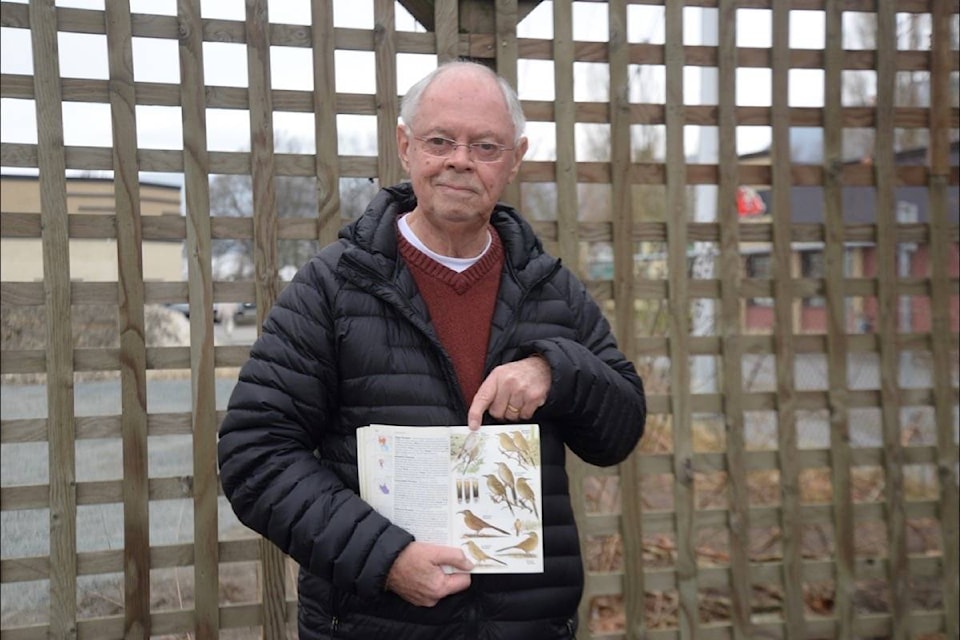There’s an extreme hobby in B.C. that takes competitors on wild chases across the province, hunting only for glimpses of feathered rarities.
Many have made the mistake of calling them bird-watchers. But the notebook-carrying, binocular-wearing, bird-loving British Columbians prefer to be called “birders.”
A lot of birders don’t pick up the hobby until later in life, post-retirement even. But Agassiz resident Murray Brown took an interest in birds when he was just a kid.
At nine-years-old he spotted his “spark bird;” a red-winged blackbird that would start a lifelong obsession with winged-creatures around the world.
“I didn’t know a robin from a crow,” Brown recalled. “But after [the blackbird] I wanted to know, ‘how can you tell a mallard duck from a green-winged teal duck?’ The questions started pouring in.”
And his fascination only grew. Brown’s field guide contains “a lifetime worth of ticks;” 425 birds positively identified in B.C., 462 for Canada and 600 in total for North America.
But birding has changed since Brown was a kid. The internet has connected birders everywhere, providing real-time updates and news about the surprisingly fast-paced hobby.
eBird is a website that allows users to submit their observations and explore data from around the globe. Photos, bird-chirp audio files and birding “hot spots” are only a click away for dedicated birders, not to mention travel tips for the affluent among the birding community.
Brown himself is an active member of the online birding world and receives daily email updates to stay on top of the newest trends and discoveries. He is also a member of the British Columbia Field Ornithologists (BCFO), a non-profit encouraging the study, preservation and enjoyment of B.C.’s wild birds.
Despite the modernization of an age-old pastime, Brown hasn’t stopped recording his birds by hand. Pages of ticks illustrate his dedication to bird discovery and a deep appreciation for the region’s biodiversity. It’s as if Brown is collecting the birds, despite the fact that all he has to show for each find is a penciled tick and sometimes a photo.
From Eurasian collard-doves and calliope hummingbirds to gold-crowned kinglets and yellow-bellied flycatchers, Brown has seen (almost) all there is to see and has no plans of stopping. He said his 425 B.C. birds are impressive, but shy in comparison to some of the birders he’s met.
“In B.C., if you’ve seen 400 birds…That’s a milestone, that’s a benchmark. You can pretty much relax after that, you don’t need to prove yourself anymore,” he said. “I’ve got 425 and even though that’s worth bragging about, I meet people occasionally who have 471 or 478 [and] there’s around 500 bird species in B.C.”
“They will spend any amount of energy or money to go get a bird,” Brown said of some of the province’s extreme birders.
In fact, a recent visit from a northern cardinal has caused a stir in Cranbrook, B.C.
The little cardinal drew birders from around the province, including Brown and some of his birding colleagues - on a nearly 10-hour drive to catch a glimpse of the bird, whose range normally extends only from the southern and eastern United States into Ontario.
While Brown missed spotting the little Cranbrook cardinal, seeing a bird out of its regular jurisdiction wouldn’t be a first for the life-long birder.
READ: Rare bird visit to Cranbrook sparks BC-wide interest
One of his favourite finds happened in spring, 2011 when he wasn’t looking for birds at all. While walking his cockapoo near the boat launch in Harrison, Brown saw a Sage Thrasher, a bird that is rarely, if ever, recorded outside of Sage Brush Country –Washington, Arizona or Oregon.
“It was very uncommon,” Brown recalled. “I immediately went online and spread the word –within hours there were people coming up from Vancouver with binoculars and cameras to see if I was accurate.”
The natural question is, how do these birds end up so far from home?
“It tells me that birds are like humans –they get lost,” Brown said, adding that “reverse migration” is a phenomenon that sometimes causes birds to fly north when they are intended to go south and vice versa.
He noted how a redwing thrush, native to Europe and Asia has been visiting Victoria, B.C. for years.
With bird behaviour so unpredictable, how do birders prove that they’ve really seen what they’re claiming?
Birders operate on an honour system, Brown explained. And usually those who lie, have their lies uncovered when probed.
“If you [are] ever found out that you cheated, that you lied, you’re name is mud,” he said. “You’re back to zero.”
But aside from the glory and adrenaline of finding a new species, the fundamental purpose of Birding is conservation.
Brown recalls how, when he first moved to Agassiz, a three-acre parcel of land next to his home housed a miniature ecosystem.
Amidst the bush, plants and grasses sat massive, broad-leaved maple trees and one hawthorn. A tiny stream next to the fence contributed to the thriving biodiversity developing right next to human life.
“Consequently those bits of habitat draw the birds. Particularly during migration –spring and fall,” Brown said. “I started keeping a list of the birds I saw –a yard list– you record any bird from your yard that you can identify.”
But about ten years after Brown moved next door, a multi-family complex was built over the miniature ecosystem.
The final bird noted in his yard book was a falcon recorded in January, 2017.
“It occurred to me, this is what habitat loss looks like. I’m witnessing it firsthand,” he said. “[The land] used to have coyotes running around in it. Now it houses humans, period.”
Brown says birding groups around the country hope to educate others on habitat loss and lobby municipalities and developers to consider habitats when zoning or building.
“My mission or mandate now is to try to encourage people to appreciate what we have left because there are species disappearing very rapidly.”
